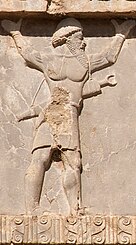
Back Satagídia Catalan Satagidia Spanish ثتهگوش Persian Satagidija Croatian Sattagidia Italian 삿타기디아 Korean Саттагидия Russian Satagidija Serbo-Croatian Satagidija Slovenian Саттагідія Ukrainian
| Sattagydia | |||||||||
|---|---|---|---|---|---|---|---|---|---|
| Satrapy of the Achaemenid Empire | |||||||||
| 513 BCE–c. 4th century BCE | |||||||||
 Sāttagydiⁿa was part of the eastern territories of the Achaemenid Empire | |||||||||
| Government | |||||||||
| • Type | Monarchy | ||||||||
| King or King of Kings | |||||||||
• 513–499 BCE | Darius I (first) | ||||||||
• 358–338 BC | Artaxerxes III | ||||||||
| Historical era | Achaemenid era | ||||||||
| 513 BCE | |||||||||
• Disestablished | c. 4th century BCE | ||||||||
| |||||||||
| Today part of | |||||||||
Sattagydia
Sattagydian Achaemenid soldier
Xerxes I tomb, Sattagydian soldier circa 480 BCE (detail).

Sattagydia (Old Persian: 𐎰𐎫𐎦𐎢𐏁 Thataguš, country of the "hundred cows") was one of the easternmost regions of the Achaemenid Empire, part of its Seventh tax district according to Herodotus,[5] along with Gandārae, Dadicae and Aparytae.[6][7][8] It was situated east of the Sulaiman Mountains up to the Indus River in the basin around Bannu in modern day's southern Khyber Pakhtunkhwa, Pakistan.[9]
- ^ "Susa, Statue of Darius - Livius". www.livius.org.
- ^ Yar-Shater, Ehsan (1982). Encyclopaedia Iranica. Routledge & Kegan Paul. p. 10. ISBN 9780933273955.
- ^ Naqs-e Rostam – Encyclopaedia Iranica.
- ^ Naqs-e Rostam – Encyclopaedia Iranica List of nationalities of the Achaemenid military with corresponding drawings.
- ^ Herodotus III 91, III 94
- ^ Mitchiner, Michael (1978). The ancient & classical world, 600 B.C.-A.D. 650. Hawkins Publications ; distributed by B. A. Seaby. p. 44. ISBN 9780904173161.
- ^ Jigoulov, Vadim S. (2016), The Social History of Achaemenid Phoenicia: Being a Phoenician, Negotiating Empires, Routledge, p. 21, ISBN 978-1-134-93809-4
- ^ Eggermont, Alexander's Campaigns in Sind and Baluchistan 1975.
- ^ Fleming, Achaemenid Sattagydia 1982, p. 105.



